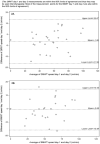Physical function and mobility in children with congenital myotonic dystrophy
- PMID: 27859360
- PMCID: PMC5436951
- DOI: 10.1002/mus.25482
Physical function and mobility in children with congenital myotonic dystrophy
Abstract
Introduction: Congenital myotonic dystrophy (CDM) occurs when symptoms of myotonic dystrophy present at birth. In this study we evaluated the relationship between physical function, muscle mass, and age to provide an assessment of the disease and help prepare for therapeutic trials.
Methods: CDM participants performed timed functional tests (TFTs), the first 2 minutes of 6-minute walk tests (2/6MWTs), and myometry tests, and also performed dual-energy X-ray absorption (DEXA) scans. Healthy controls (HCs) performed TFTs, 6MWTs, and myometry.
Results: Thirty-seven children with CDM and 27 HCs (age range 3-13 years) participated in the study. There were significant differences in the 10-meter walk (11.3 seconds in CDM vs. 6.8 seconds in HC) and 2MWT (91 meters in CDM vs. 193 meters in HCs). DEXA lean mass of the right arm correlated with grip strength (r = 0.91), and lean mass of the right leg correlated with 6MWT (r = 0.62).
Conclusion: Children with CDM have significant limitations in strength and mobility. The tests performed were reliable, and lean muscle mass may serve as a useful biomarker. Muscle Nerve 56: 224-229, 2017.
Keywords: 6-minute walk test; congenital myotonic dystrophy; functional outcomes; myotonic dystrophy, mobility measures.
© 2016 Wiley Periodicals, Inc.
Figures
References
-
- Mahadevan M, Tsilfidis C, Sabourin L, et al. Myotonic dystrophy mutation: an unstable CTG repeat in the 3′ untranslated region of the gene. Science. 1992;255:1253–5. - PubMed
-
- Fu YH, Pizzuti A, Fenwick RG, Jr, et al. An unstable triplet repeat in a gene related to myotonic muscular dystrophy. Science. 1992;255:1256–8. - PubMed
-
- Brook JD, McCurrach ME, Harley HG, et al. Molecular basis of myotonic dystrophy: expansion of a trinucleotide (CTG) repeat at the 3′ end of a transcript encoding a protein kinase family member. Cell. 1992;69:385. - PubMed
-
- Canavese F, Sussman MD. Orthopaedic manifestations of congenital myotonic dystrophy during childhood and adolescence. J Pediatr Orthop. 2009;29:208–13. - PubMed
Publication types
MeSH terms
Grants and funding
LinkOut - more resources
Full Text Sources
Other Literature Sources
Miscellaneous



